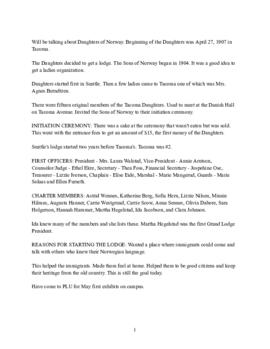Identity elements
Reference code
Name and location of repository
Level of description
Title
Date(s)
- 1982-07-26 (Creation)
Extent
2 file folders
2 sound cassettes
2 compact discs
Content and structure elements
Scope and content
This interview was conducted with Ida Apalseth on May 14, 1979 and focuses on the Daughters of Norway, including the Seattle lodge, the Tacoma lodge, early days of the organization, officers' duties, lodge activities, and scholarships.
Also see personal interview with Ida Apalseth.
Folder Contents
Box 1, File 30 Personal and Family History
Tape Archive Sheet and Tape Index
Box 1, File 30A Correspondence and Forms
Release Form
Handwritten Tape Archive Sheet and Family Background
System of arrangement
Interviewed by Julie Wilson
Transcribed by Mary Sue Gee, Julie Peterson and Becky Husby
Encoded by Kerstin Ringdahl & Amity Smetzler
Recording Quality: Good
Conditions of access and use elements
Conditions governing access
Physical access
Technical access
Conditions governing reproduction
Languages of the material
Scripts of the material
Language and script notes
Finding aids
Acquisition and appraisal elements
Custodial history
Immediate source of acquisition
Appraisal, destruction and scheduling information
Accruals
Related materials elements
Existence and location of originals
Existence and location of copies
Related archival materials
Related descriptions
Notes element
General note
Historical Note
The Daughters of Norway was first established to make Norwegian immigrants feel at home in America and provide them with a place to speak their language and share their emigration experiences with fellow Norwegians. When the organization first began, sick benefits were also provided for the members. A total of 29 lodges have been established along the West Coast, 11 of which still existed at the time of this interview.
Seattle's first lodge started in 1905, one year after the Sons of Norway began, and Tacoma's lodge began on April 24, 1907. Charter members were Astrid Wennes, Katherine Berg, Sofia Hern, Lizzie Nilsen, Minnie Hilmes, Augusta Hanner, Carrie Westgrund, Carrie Scow, Anna Sennes, Olivia Dabroe, Sara Holgerson, Hannah Hammer, Martha Hegelstad, Ida Jacobson, and Clara Johanson.
The lodge has various officer positions, each with specific duties: the President oversees, the Secretary does the correspondence work, the Financial Secretary collects dues, the Treasurer handles the money, the Judge, who is the past president, makes sure all operations are in order, the Chaplain reads the prayers, opens meetings, and organizes entertainment, the Marshall does the floor work, assists new members, and carries out initiations, and the Guard visits with new members. There are also three trustees who oversee the bills. In addition to the regular lodge, a Grand Lodge also exists and consists only of a President, Vice-President, Financial Secretary, Treasurer, three Auditors, and an Editor for the paper.
Most officers stay for two years and have the opportunity to move up. Activities in the lodges include fund-raisers, smørgasbords, sewing, baking, and drill team. In the past, the Tacoma lodge has also taught Norwegian at Lincoln High School. Education is very important to the Daughters of Norway, and they now provide scholarships for students attending a four-year college that have good grades and a Norwegian background.
Although the Daughters of Norway lodges on the East Coast have now merged with the Sons of Norway, the Daughters of Norway on the West Coast still remain separate and believe that their independence is an important aspect of the organization. At the time of this interview, Tacoma had the largest lodge on the West Coast with 228 registered members.

